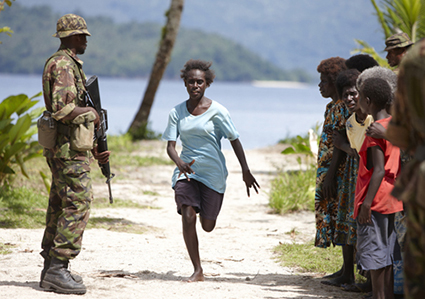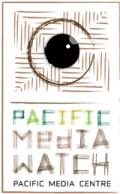
Kristian Lasslett
MELBOURNE (Arena Magazine/Pacific Media Watch): COMMENTARY: Mr Pip, a recent film set during the 1990s Bougainville war, deals with the disorienting impact of sudden trauma and the struggle survivors endure to break the subsequent bondage of grief.
This searching narrative is channelled through the character of Mr Watts, a British expatriate played by Hugh Laurie, who has assumed the improvised role of village schoolteacher in rural Bougainville.
Here Mr Watts develops a friendship with a young Bougainvillean student, Matilda, played by the extraordinary Xzannjah Matsi.
Both have endured personal loss; together they find solace in Charles Dickens’ Great Expectations.
The stage for this cathartic friendship is the very real Bougainville conflict, a war that shook the island—which forms part of Papua New Guinea’s easternmost border—for a decade, leaving in its wake a death toll of between 10,000 and 20,000 people.
In a region famed for its physical beauty and cultural majesty, the conflict was an unimaginable tragedy. And it was punctuated by war crimes that even today are only faintly acknowledged in the historical annals.
The associated trauma continues to loom large for Bougainville’s people. But for those who organised these war crimes it is something of a footnote: no one—not a soul—has ever been held to account.
Visceral reminder
Mr Pip is a visceral reminder of the impunity enjoyed by the conflict’s architects. And the film makes no pretence about the horrors of war or the immense suffering endured by those caught in the middle.
Nor does it overlook the profound courage of the Bougainvilleans who faced these horrors and their unyielding capacity to survive under the most inhospitable of conditions. But what many people outside Bougainville watching Mr Pip would not notice—yet it is subtly present in each frame—is the role of the Australian government, who primed the military violence that, in turn, presaged horrific war crimes.
These crimes are recreated in Mr Pip with unflinching realism. Indeed, while it is fictionalised account, the film mirrors the conflict’s lived brutality: each crime audiences bear witness to actually happened, on a systematic basis. In the film’s prologue the scene is set.
We learn that Bougainville is at war after traditional landowners forcefully closed a large copper mine owned by Anglo-Australian giant Rio Tinto. Later in the film we survey the scars left by the mine on the land and its people.
The mine itself was a wholly Australian invention. It was developed by the Australian colonial administration during the 1960s, in collaboration with Australian miner Conzinc Rio Tinto.
When locals resisted the alienation of their land and the destruction of the environment, they were met with police riot squads.
At one stage the colonial administration even contemplated deploying the military—wiser heads prevailed in the end. The protests continued throughout the mine’s life.
Mine 'benefits'
Initially they centred on the distribution of mine "benefits"—the lion’s share went to the Papua New Guinea government and the major shareholder, Rio Tinto. However, as the mine’s seismic social, environmental and economic effects began to seriously erode the cultural, customary and spiritual life of the land’s custodians, protest turned into expropriation.
In late 1988 landowner leaders turned to dynamite as their preferred tool to evict the mine’s operator, Bougainville Copper Limited (BCL), which is a subsidiary of Rio Tinto.
Mr Pip takes place in the early 1990s. By then many villages around the mine had been levelled by Papua New Guinea Defence Force (PNGDF) soldiers, and police mobile squads.
Initially the Papua New Guinea government had baulked at the prospect of deploying force against landowners, such is their status in Melanesia.
When advised that the government planned to "appease" the landowners, BCL’s chairman threatened to withdraw Conzinc Rio Tinto’s investments from Papua New Guinea, which would have bankrupted the nation.
The Australian government heaped on the pressure too.
A senior diplomat stationed in Australia’s Papua New Guinea high commission recalls, "we were certainly pushing them … to get more troops over there and that sort of thing. Ben Sabumei was the [Papua New Guinea Defence] Minister, and I used to see him all the time saying, 'get your people over there'."
When Papua New Guinea’s security forces arrived, landowner leaders in the mine-affected region organised an armed resistance force dubbed the Bougainville Revolutionary Army (BRA). They called on their Bougainvillean compatriots to support a campaign of secession.
The BRA leadership believed this was the only remaining political route through which social justice for marginalised rural communities could be achieved.
This work is licensed under a Creative Commons Attribution-NonCommercial 3.0 New Zealand Licence.




